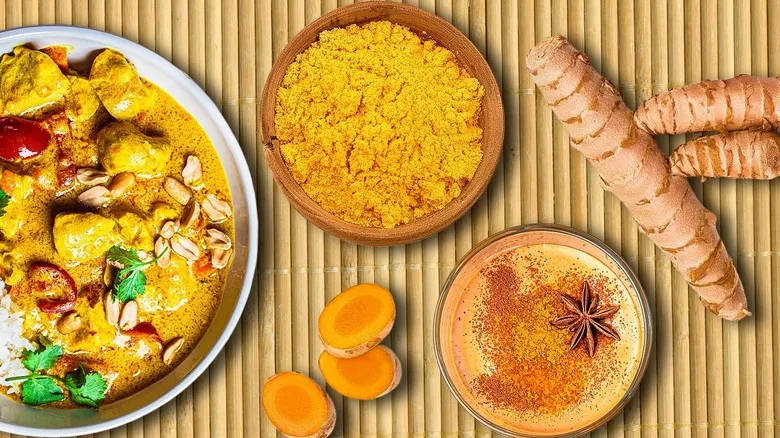What is turmeric?
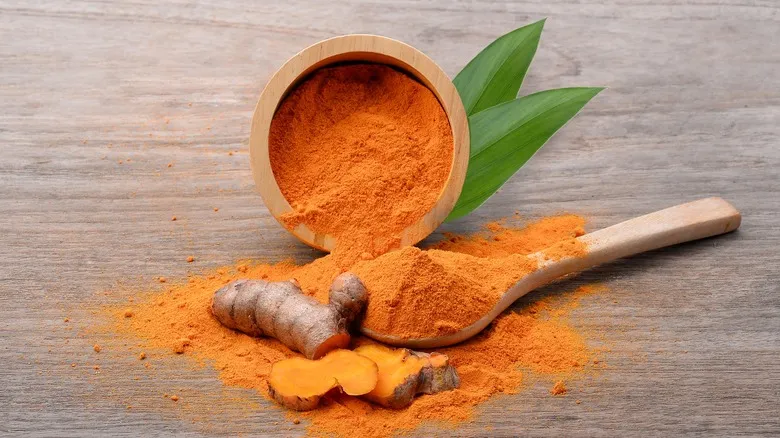
Turmeric is a vibrant yellow-orange root derived from the plant known as Curcuma longa. Belonging to the ginger family, it shares similar spicy, earthy, and rich flavor characteristics. This plant is indigenous to Indonesia and southern India, thriving in monsoon forests where the environment is consistently warm and humid. Typically reaching heights of 3 to 4 feet, turmeric grows in a compact, bushy form, resembling a canna lily with its pink, ginger-like flowers.
Turmeric can be prepared in various ways and is commonly used in curry and mustard for its distinct flavor and color. Surprisingly, it also contributes to the yellow hue of potato bread. Additionally, it finds its way into pickles, relishes, and a wide array of other dishes. Currently, the primary producers of turmeric include India, China, Myanmar, Nigeria, and Bangladesh.
A brief history of turmeric cultivation and use
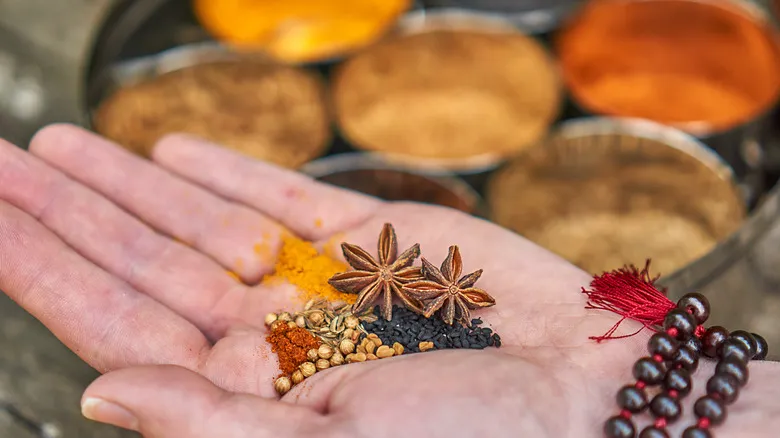
Turmeric boasts a rich history that dates back nearly four thousand years. It was initially cultivated in India before making its way to China and spreading along spice trade routes to various regions of Eurasia and Africa. In India, turmeric served multiple purposes, including culinary uses, textile dyeing, medicinal applications, and religious rituals, often symbolically applied to attract good fortune. Historical accounts suggest that the Egyptians utilized it for wound treatment and as a dye for fabrics around 3,500 years ago, thanks to its vibrant and staining qualities.
Over time, turmeric found its way across the globe. Today, it is a fundamental spice in Ethiopian cuisine and is also cultivated in Central America and the Caribbean, among other tropical regions. While it is known by various names in different cultures, the English term derives from the Latin phrase "terra merita," which translates to "meritorious earth," due to its resemblance to a paint pigment. Interestingly, those with a creative flair might be intrigued to learn that turmeric can be used for painting as well.
The flavor of turmeric
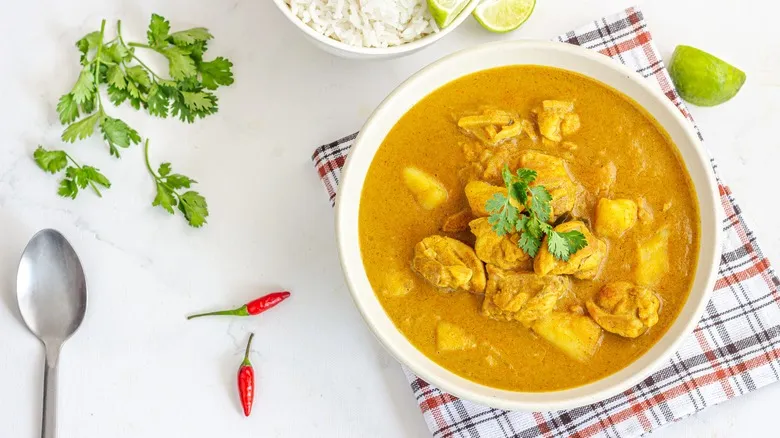
Turmeric boasts a warm, earthy, and spicy flavor profile. It's not merely hot; many describe its taste as peppery, with hints of citrus that contribute to its complexity. Similar to salt, turmeric can elevate the flavors of other seasonings in a dish. While it has a bitter note, it's a pleasant bitterness that provides a strong contrast to pepper and umami flavors. The flavor of turmeric powder is milder and less intense than that of fresh root, and it may lose potency over time.
Interestingly, turmeric also complements sweet dishes. Much like the naturally bitter notes of chocolate, it pairs beautifully with honey, syrup, or sugar, as well as traditional dessert spices like cinnamon, nutmeg, and cloves, enhancing their flavors and aromas. Rather than taking center stage, turmeric shines best as a subtle addition to desserts, such as in the dough for cinnamon rolls or ginger puddings.
Common varieties of turmeric
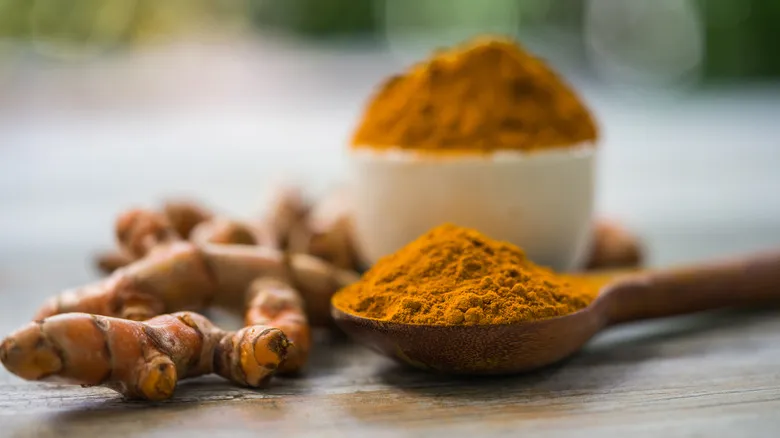
There are numerous types of turmeric that an experimental chef may wish to explore. In addition to Curcuma longa, which has a close relative known as Curcuma aromatica or wild turmeric, there are various cultivars (different strains of the species) available.
While over 50 cultivars exist, most home cooks typically encounter only one or two during their regular shopping trips. These commonly include Madras, favored in the U.K. and the Middle East, and Alleppey, which is more popular in the U.S. The former is known for its vibrant color, while the latter boasts a more robust flavor and aromatic profile.
If you take the time to seek out different types of turmeric, you’ll find several options. These include black turmeric (Curcuma caesia) and white turmeric (Curcuma zedoaria), along with various color variations influenced by the growing conditions in different regions. It’s important to note that not all products labeled as turmeric are meant for culinary use; some are intended for medicinal purposes. Always verify the ingredient before using it in your cooking.
Available forms of turmeric
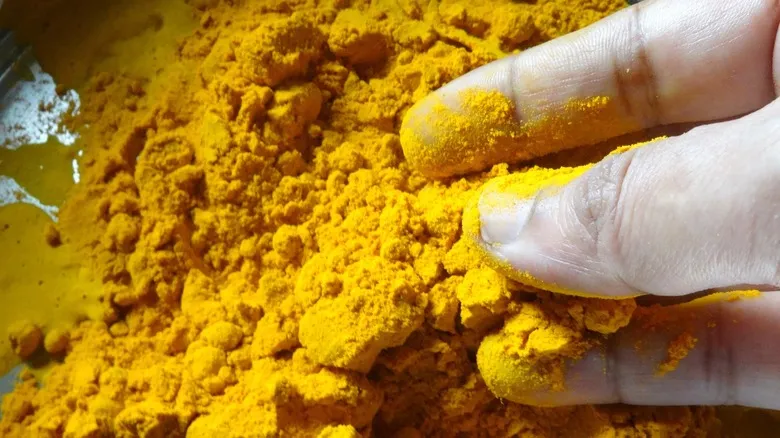
Turmeric is available in various forms, most of which can be found at contemporary grocery stores. Fresh turmeric root is typically located in the produce section, near ginger. If it's not available at your local grocery store, consider visiting a shop that specializes in Indian or Southeast Asian foods, where you're more likely to find it in its raw state.
If you prefer not to deal with selecting, preparing, and storing the fresh root, you can opt for dried turmeric, which comes in powdered or sliced varieties. While dried slices may be more challenging to find, they are often available online if not at a health food store. Whole dried roots can also be purchased online or at herbal shops. Most grocery stores will carry at least a bottle of ground turmeric in the spice aisle, making it a good starting point if you're new to using this spice.
You can also typically find some form of turmeric in the tea section. However, in this case, it will be offered as loose leaf or bagged tea rather than on its own. This is an excellent way to enjoy the antioxidant benefits of turmeric, even though the pre-packaged tea isn't suitable for cooking.
How turmeric is processed

Turmeric root is not simply harvested and sold as is; it goes through a detailed preparation process before it is available in the familiar form of a yellow-orange powder. Initially, the rhizomes are boiled or steamed to lessen their strong aroma. In the past, turmeric was traditionally prepared with leaves and cow dung, which reacted with the natural compounds in turmeric to create a sought-after product (no pun intended). Thankfully, this method is no longer used in contemporary processing.
Today, the roots are cooked in a simple solution of water mixed with a small amount of sodium bicarbonate, commonly known as baking soda. After cooking, they are dried, polished, and then ground into a fine powder before being packaged for sale.
Some sources claim that Indian turmeric is the finest in the world, accounting for a significant portion of the global supply and consuming about 80 percent of it. However, as long as you purchase dried or powdered turmeric from a reputable source, you are likely to receive a quality product. What defines a reputable supplier? Look for a physical address on the packaging in the store, and if you're uncertain, do a quick online search to verify their credibility.
How to choose the best turmeric at the store
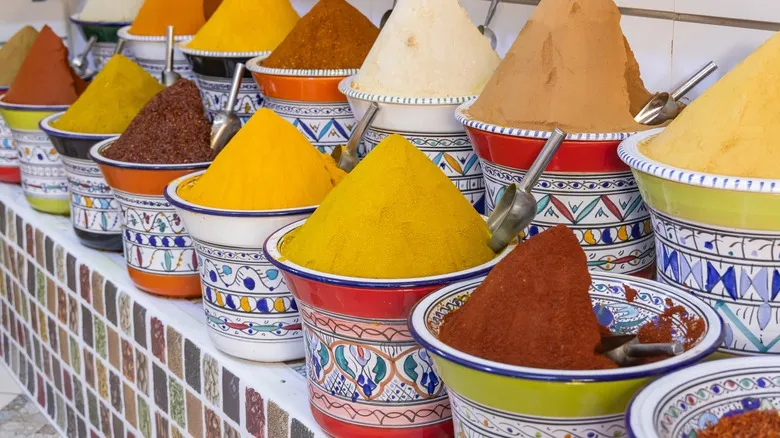
There are numerous turmeric options available at large retailers, and you'll discover even more choices online. The selection you make will depend on your culinary or health goals. The best way to determine the type of turmeric you need is by referring to your recipe. For example, many curry dishes require powdered turmeric, while fresh turmeric might be a great addition to a smoothie. Always follow the guidance of the recipe creator for optimal results.
That said, many people recommend using raw turmeric root, as it is more nutrient-rich than the dried and powdered forms due to its higher curcumin content. If you come across a recipe that calls for raw turmeric, it’s worth considering. When selecting raw turmeric, look for firm, uniformly colored roots that are free from blemishes or soft spots. If you opt for dried turmeric, be sure to check the expiration date to ensure the spice is still fresh.
Common uses for turmeric in the kitchen

Turmeric is a fantastic ingredient for soups, stews, curries, breads, and even sweet treats like Middle Eastern sfouf. It enhances meat dishes and tagines, imparting a robust and earthy flavor that elevates chicken, beef, lamb, or goat. (If you have access to an African or Middle Eastern meat market, consider incorporating goat into your protein options and pairing it with curry whenever you can.)
Yet, turmeric's versatility extends beyond the cuisines of Africa, Asia, or the Middle East. Ree Drummond even incorporates it into her mac and cheese, demonstrating that turmeric can be a staple beyond health food aisles. You can easily blend it into everyday meals like pasta, eggs, rice, vegetable dips, and smoothies. For those who enjoy mixology, turmeric can add a unique twist to cocktails. Imagine a refreshing drink made with vodka, lime, maple syrup, tonic water, and turmeric—a vibrant, herbal beverage perfect for sipping on the patio.
When using fresh turmeric, it's best to mince or grate it finely. Similar to ginger root, fresh turmeric is quite firm, so using a microplane or cheese grater is effective for incorporating raw root into your dishes. Alternatively, you can puree the root and strain it through a nut bag to extract the juice.
Turmeric milk: Your Ayurvedic sleep aid

Have you ever come across golden milk? Curious about the origin of its name? If you guessed turmeric, you’re spot on! Golden milk is a popular drink known for its warming and soothing properties, often recommended to aid sleep and endorsed by Ayurvedic practices. It’s simple to prepare and surprisingly tasty, especially once you get past the initial surprise of combining turmeric's bold flavor with creamy milk and sweeteners. Everyone should learn how to make it!
Fortunately, it’s quite easy. You’ll need some milk—many recipes suggest using plant-based alternatives, but regular dairy works just as well. For a single serving, gather 2 cups of milk and a teaspoon of ground turmeric. You can also add optional ingredients like honey, maple syrup, cinnamon, black pepper, coconut oil, and ginger, but the essential components are just the milk and turmeric. Combine everything in a pot on the stove and bring it to a gentle simmer. Let it simmer for about 10 minutes to allow the flavors to meld. Pour it into a mug and savor it while it’s warm.
Curry and other turmeric spice mixes

Looking to create your own curry powder? Turmeric is your go-to ingredient. It's a key component in curry (especially the yellow variety) and contributes to its vibrant flavor. Along with powdered turmeric root, most curry blends typically include coriander, cumin, ginger, mustard, black pepper, cinnamon, cardamom, and cayenne or chili powder.
You can also whip up a straightforward vegetable seasoning by mixing ground turmeric, paprika, oregano, and garlic powder in a 2:2:5:4 ratio. Furthermore, you can prepare a golden milk spice blend to have on hand for a comforting turmeric nightcap. Simply combine the dry ingredients according to your favorite recipe's ratios, scaled up to your desired quantity. Once blended, store it in an airtight container just like you would with other spices.
Lastly, consider crafting an all-natural anti-inflammatory mix. This blend consists of turmeric, ginger, and pepper in a 5:2:1 ratio. It can be added to soups, stews, and curries, but also works well in less conventional dishes like savory oatmeal, green tea lattes, or tofu scrambles.
Substitutes for turmeric
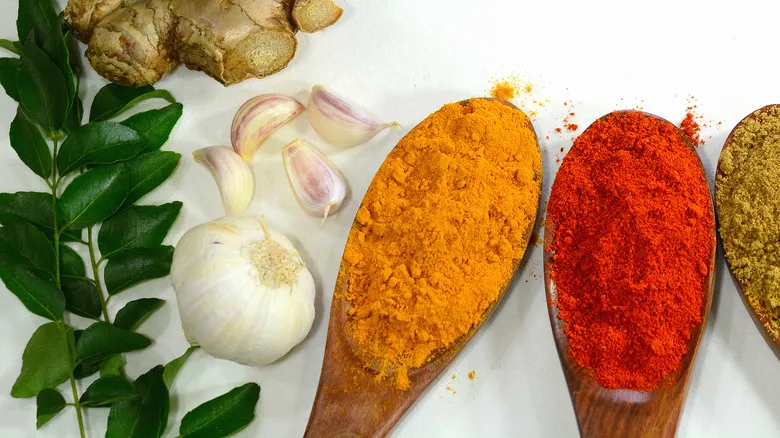
The ideal alternative to turmeric is, whenever possible, turmeric itself. Therefore, if you can't locate dried turmeric in your pantry but have fresh turmeric on hand, or vice versa, feel free to use it in its other form. A general guideline for substituting fresh herbs for dried ones is to apply a 3:1 ratio. For example, if a recipe calls for 1 tablespoon of ground turmeric, you should use 3 tablespoons of grated fresh turmeric. Conversely, if you need 1 tablespoon of fresh turmeric, use ? tablespoon of dried turmeric, which is equivalent to a teaspoon.
While turmeric has a unique flavor profile, you can find alternatives if necessary. Common substitutes for flavor include curry powder, which has a significant amount of turmeric, or a blend of ginger and cumin if curry powder isn't available. For color, saffron is a good choice. Paprika can also provide an earthy warmth, and mustard, which contains turmeric, can assist with color as well. Additionally, galangal, a relative of both ginger and turmeric, is another viable option.
Growing your own turmeric
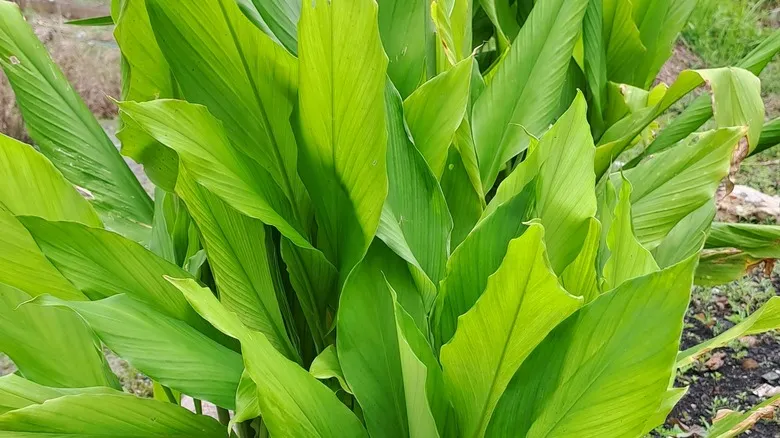
Absolutely, you can cultivate your own turmeric! In most regions of the U.S., it’s best to grow it indoors. However, in USDA zones 8-11, it can thrive outdoors as a perennial, making it suitable for gardens in much of the Southern U.S. and along the West Coast. Turmeric is not a particularly demanding plant, and growing it yourself allows you to enjoy fresh rhizomes for a large part of the year.
To successfully grow turmeric, ensure it receives full sun or partial shade, and maintain consistent moisture. While it can tolerate wet conditions, it's important to plant it in well-drained soil. If you're growing it in pots indoors, you can take it outside during the summer after the last frost has passed.
Keep in mind that turmeric can easily stain surfaces. This applies to both harvesting the roots and using them in cooking. Fortunately, common food stains from turmeric can be removed fairly easily with baking soda, vinegar, or alcohol.
Health benefits of turmeric
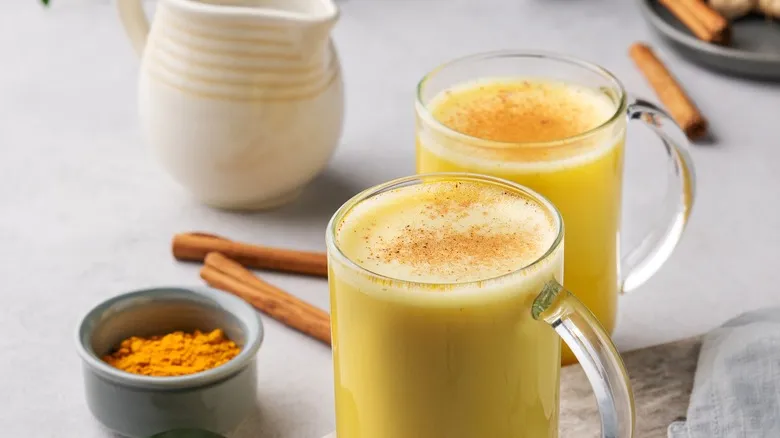
Turmeric has been utilized for centuries by traditional healers in India and China. It was traditionally applied to address respiratory and digestive issues, as well as concerns related to skin and joints. In contemporary times, it is promoted as a remedy for a variety of health issues, including arthritis, gastrointestinal conditions, allergies, mood disorders, and more.
Research has also suggested that turmeric may serve as a sleep aid. A study published in the journal Molecular Nutrition & Food Research found that turmeric extract enhances non-REM sleep in mice, suggesting it could be a potential remedy for insomnia in humans. Some advocates of turmeric highlight its mood-regulating properties, which may also contribute to improved sleep, explaining its inclusion in turmeric milk as a non-alcoholic nightcap.
The health benefits of turmeric primarily arise from curcuminoids, with curcumin being the most prevalent, along with other related compounds. However, research on its specific effects and the extent of its benefits for various conditions remains inconclusive, as studying turmeric can be challenging due to its instability, low bioavailability, and the presence of other substances that can complicate results.
Nonetheless, studies indicate that turmeric may have the potential to combat cancer cells. Given its historical use and minimal serious side effects, incorporating it into your diet in moderate amounts (such as what you would typically use in cooking) is likely beneficial.
Storing turmeric to last

Both spices and seasonings deteriorate over time, but there are effective methods to store them for optimal flavor and extended shelf life. It's important to recognize that, regardless of your efforts, the flavor of dried spices will gradually fade. Compounds naturally evaporate, and exposure to direct sunlight can accelerate the breakdown of these chemical compounds. While this is beneficial for eliminating bacteria in laundry, it’s not ideal for your seasonings.
To maintain their quality, always store dried spices in a cool, dry, and dark environment. Keeping them away from moisture will prevent spoilage, and shielding them from light and heat will help preserve the flavor-enhancing curcuminoids for a longer period. If you find it inconvenient to rummage through a cupboard for your seasonings each time you need them, consider installing a pull-out drawer for easy access while still keeping the spices in darkness most of the time. Just be sure to use a drawer organizer to avoid clashing glass containers.
For fresh turmeric root, wash and dry it thoroughly, then wrap it in a paper towel and place it in a Ziploc bag, ensuring all the air is squeezed out. This method will keep it fresh for a few weeks in the refrigerator or up to six months in the freezer.
Nutritional information
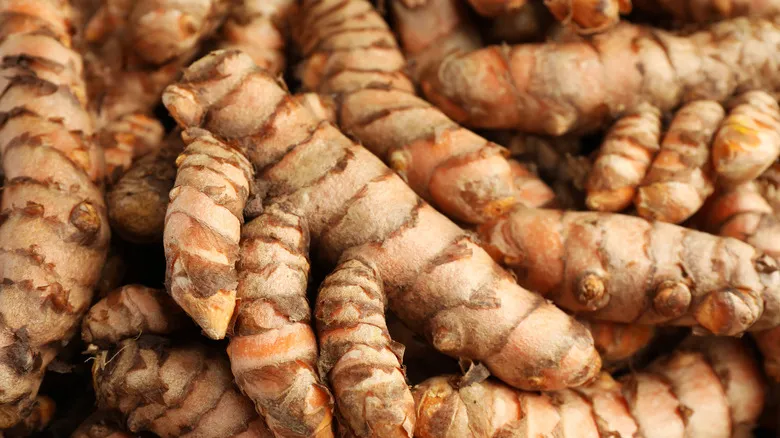
Turmeric, as a spice, is low in calories yet packed with health benefits. You can freely incorporate it into your meals without significantly altering their macronutrient profile or overall calorie count, while also boosting their vitamin and mineral content. Specifically, a tablespoon of ground turmeric has approximately 29 calories and provides a notable portion of your daily needs for manganese (26%), iron (16%), potassium (5%), and vitamin C (3%).
There are minimal risks linked to turmeric consumption. However, consuming it in large quantities may lead to stomach discomfort. It is also not recommended for individuals with certain health issues, such as gallstones or bile duct obstructions, as well as those with diabetes or on anticoagulant medications. Regardless, it’s always wise to consult a healthcare professional before taking large doses of any supplement. In the amounts typically found in food, turmeric is generally regarded as safe for most people.
Recommended
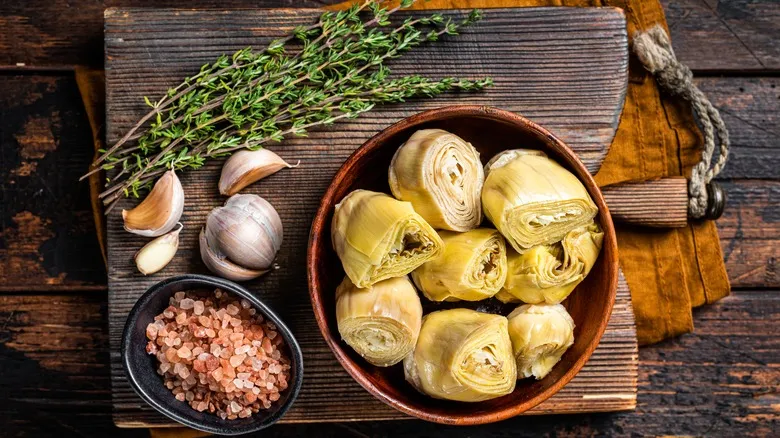
5 Delicious Ways To Eat Canned Artichoke Hearts
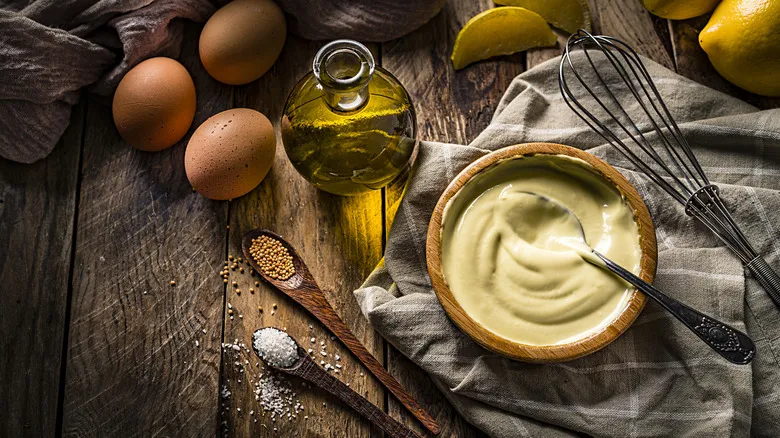
The Easy Way To Take The Bitterness Out Of Olive Oil In Mayonnaise

Rachael Ray's Rack Hack To Eliminate Avocado Prep Time
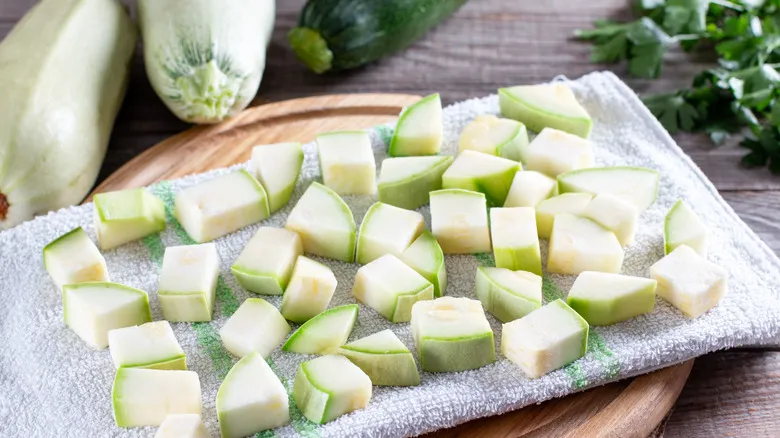
The Freezer Storage Trick To Make Zucchini Last All Summer
Next up

